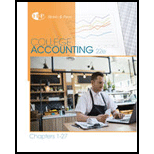
College Accounting, Chapters 1-27
23rd Edition
ISBN: 9781337794756
Author: HEINTZ, James A.
Publisher: Cengage Learning,
expand_more
expand_more
format_list_bulleted
Textbook Question
Chapter 5, Problem 1MC
LO1 The purpose of
- (a) spread the cost of an asset over its useful life.
- (b) show the current market value of an asset.
- (c) set up a reserve fund to purchase a new asset.
- (d) expense the asset in the year it was purchased.
Expert Solution & Answer
Want to see the full answer?
Check out a sample textbook solution
Students have asked these similar questions
Accounting discuss
Can you explain the correct approach to solve this general accounting question?
General accounting question ?
Chapter 5 Solutions
College Accounting, Chapters 1-27
Ch. 5 - The matching principle in accounting requires the...Ch. 5 - Prob. 2TFCh. 5 - LO1 As part of the adjustment of supplies, an...Ch. 5 - LO1 Depreciable cost is the difference between the...Ch. 5 - LO1 The purpose of depreciation is to record the...Ch. 5 - LO1 The purpose of depreciation is to (a) spread...Ch. 5 - Prob. 2MCCh. 5 - Prob. 3MCCh. 5 - Prob. 4MCCh. 5 - The first step in preparing a work sheet is to (a)...
Ch. 5 - On December 31, the trial balance indicates that...Ch. 5 - LO2 When posting adjusting entries to the general...Ch. 5 - Prob. 3CECh. 5 - Prob. 4CECh. 5 - LO5 Using the following partial work sheet...Ch. 5 - Prob. 6CECh. 5 - Prob. 1RQCh. 5 - Prob. 2RQCh. 5 - Prob. 3RQCh. 5 - Prob. 4RQCh. 5 - Prob. 5RQCh. 5 - Prob. 6RQCh. 5 - Prob. 7RQCh. 5 - Prob. 8RQCh. 5 - What is an assets depreciable cost?Ch. 5 - Prob. 10RQCh. 5 - Prob. 11RQCh. 5 - Identify the five major column headings on a work...Ch. 5 - List the five steps taken in preparing a work...Ch. 5 - Prob. 14RQCh. 5 - Explain when revenues are recorded under the cash...Ch. 5 - Prob. 16RQCh. 5 - ADJUSTMENT FOR SUPPLIES On December 31, the trial...Ch. 5 - Prob. 2SEACh. 5 - ADJUSTMENT FOR WAGES On December 31, the trial...Ch. 5 - ADJUSTMENT FOR DEPRECIATION OF ASSET On December...Ch. 5 - CALCULATION OF BOOK VALUE On June 1, 20--, a...Ch. 5 - ANALYSIS OF ADJUSTING ENTRY FOR SUPPLIES Analyze...Ch. 5 - Prob. 7SEACh. 5 - POSTING ADJUSTING ENTRIES Two adjusting entries...Ch. 5 - WORK SHEET AND ADJUSTING ENTRIES A partial work...Ch. 5 - JOURNALIZING ADJUSTING ENTRIES From the...Ch. 5 - Prob. 11SEACh. 5 - ANALYSIS OF NET INCOME OR NET LOSS ON THE WORK...Ch. 5 - CASH, MODIFIED CASH, AND ACCRUAL BASES OF...Ch. 5 - ADJUSTMENTS AND WORK SHEET SHOWING NET INCOME The...Ch. 5 - ADJUSTMENTS AND WORK SHEET SHOWING A NET LOSS...Ch. 5 - JOURNALIZE AND POST ADJUSTING ENTRIES FROM THE...Ch. 5 - Prob. 17SPACh. 5 - ADJUSTMENT FOR SUPPLIES On July 31, the trial...Ch. 5 - ADJUSTMENT FOR INSURANCE On July 1, a six-month...Ch. 5 - ADJUSTMENT FOR WAGES On July 31, the trial balance...Ch. 5 - ADJUSTMENT FOR DEPRECIATION OF ASSET On July 1,...Ch. 5 - CALCULATION OF BOOK VALUE On January 1, 20--, a...Ch. 5 - ANALY SIS OF ADJUSTING ENTRY FOR SUPPLIES Analyze...Ch. 5 - ANALY SIS OF ADJUSTING ENTRY FOR INSURANCE Analyze...Ch. 5 - POSTING ADJUSTING ENTRIES Two adjusting entries...Ch. 5 - WORK SHEET AND ADJUSTING ENTRIES A partial work...Ch. 5 - JOURNALIZING ADJUSTING ENTRIES From the...Ch. 5 - EXTENDING ADJUSTED BALANCES TO THE INCOME...Ch. 5 - Prob. 12SEBCh. 5 - CASH, MODIFIED CASH, AND ACCRUAL BASES OF...Ch. 5 - Prob. 14SPBCh. 5 - Prob. 15SPBCh. 5 - JOURNALIZE AND POST ADJUSTING ENTRIES FROM THE...Ch. 5 - CORRECTING WORK SHEET WITH ERRORS A beginning...Ch. 5 - Delia Alvarez, owner of Delias Lawn Service, wants...Ch. 5 - Prob. 1MPCh. 5 - Prob. 1CP
Knowledge Booster
Learn more about
Need a deep-dive on the concept behind this application? Look no further. Learn more about this topic, accounting and related others by exploring similar questions and additional content below.Similar questions
- I am looking for the correct answer to this general accounting problem using valid accounting standards.arrow_forwardCan you solve this general accounting problem with appropriate steps and explanations?arrow_forward(1) prepare the december 31 entry for bramble corporation to record amortization of intangibles. the trademark has an estimated useful life of 4 years with a residual value of $3,520 [it is not $3,460]arrow_forward
arrow_back_ios
SEE MORE QUESTIONS
arrow_forward_ios
Recommended textbooks for you
 College Accounting, Chapters 1-27AccountingISBN:9781337794756Author:HEINTZ, James A.Publisher:Cengage Learning,
College Accounting, Chapters 1-27AccountingISBN:9781337794756Author:HEINTZ, James A.Publisher:Cengage Learning, Intermediate Accounting: Reporting And AnalysisAccountingISBN:9781337788281Author:James M. Wahlen, Jefferson P. Jones, Donald PagachPublisher:Cengage Learning
Intermediate Accounting: Reporting And AnalysisAccountingISBN:9781337788281Author:James M. Wahlen, Jefferson P. Jones, Donald PagachPublisher:Cengage Learning- Principles of Accounting Volume 1AccountingISBN:9781947172685Author:OpenStaxPublisher:OpenStax College
 Intermediate Financial Management (MindTap Course...FinanceISBN:9781337395083Author:Eugene F. Brigham, Phillip R. DavesPublisher:Cengage Learning
Intermediate Financial Management (MindTap Course...FinanceISBN:9781337395083Author:Eugene F. Brigham, Phillip R. DavesPublisher:Cengage Learning

College Accounting, Chapters 1-27
Accounting
ISBN:9781337794756
Author:HEINTZ, James A.
Publisher:Cengage Learning,

Intermediate Accounting: Reporting And Analysis
Accounting
ISBN:9781337788281
Author:James M. Wahlen, Jefferson P. Jones, Donald Pagach
Publisher:Cengage Learning


Principles of Accounting Volume 1
Accounting
ISBN:9781947172685
Author:OpenStax
Publisher:OpenStax College


Intermediate Financial Management (MindTap Course...
Finance
ISBN:9781337395083
Author:Eugene F. Brigham, Phillip R. Daves
Publisher:Cengage Learning
Property, Plant and Equipment (PP&E) - Introduction to PPE; Author: Gleim Accounting;https://www.youtube.com/watch?v=e_Hx-e-h9M4;License: Standard Youtube License